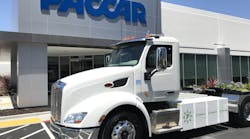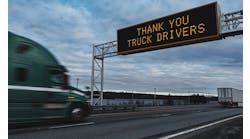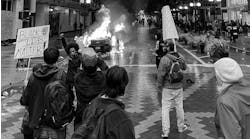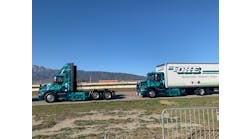The state of California is generally not a popular topic across the trucking industry.
There is a long history of environmental, economic, and labor regulations that have long frustrated truckers. Even if many of these complaints are valid, it may be a little misguided to badmouth the entire state for these reasons alone.
I mention that because last week Peterbilt Motors Co. invited a group of North American journalists to see another side of Golden State.
The gathering at the PACCAR Innovation Center in Silicon Valley gave the company a chance to show-off several recent concept truck models, including the Level 4 autonomous truck shown at CES in January, and the Walmart Advanced Vehicle Experience (WAVE) built earlier this decade.
The 26,000-square-foot center in the town of Sunnyvale opened last year, and will soon employ about 50 people, largely focused on software and electric engineering. The facility includes a five-bay truck laboratory, a 3-D printer and has helped foster the development of augmented reality technology to speed and simply truck maintenance and repairs.
Jason Skoog, Peterbilt’s general manager, said the center allows the company to collaborate with technology providers, and to better research advanced powertrain options and driver assistance systems. Jake Montero, general manager of the PACCAR Innovation Center, said the location of the facility is as important as what is going on inside the building.
Being in the heart of Silicon Valley means it is important to be an “active member” of the community, he said. That includes being involved Center for Automotive Research at Stanford University, and meeting with more than one hundred technology companies to consider potential partnerships when it makes sense.
Montero cited Nvidia to illustrate that point. Last year, the chip maker, whose technology is already used in Tesla cars, agreed to work with PACCAR to further autonomous truck development.
Educating technology suppliers about the trucking industry is part of the mission for Montero and the PACCAR Innovation Center. He pointed out that quite often these companies are discovering a stronger business case on the trucking side, rather than the automotive sector.
“What they are finding are better go-to-market opportunities in trucking,” Montero said.
Montero even expressed some cautious optimism that PACCAR’s presence in Silicon Valley could help improve trucking’s overall image in the state, especially in the area of easing testing rules for automated trucks. Currently, he said, it can be more attractive for companies to turn to neighboring Nevada.
Besides touring the center, last week’s festivities included a ride-and-drive of an all-electric Peterbilt 579 that was built in collaboration with TransPower.
The short trip around the streets of Silicon Valley was impressive, both for its quiet ride and surprising pick-up, considering it is a demonstration electric vehicle.
Besides its work with Peterbilt, TransPower is working with Meritor Inc. on electrification technologies. The company, based in Escondido, CA, is a good example of the growing number of companies operating in California that are working to offer truckers options beyond diesel fuel to power their trucks.
Of course, maybe the most well known – and certainly most hyped – electric vehicle maker is Tesla. The public unveiling of its electric Class 8 truck took place in Southern California, and it has a facility located just blocks from the PACCAR Innovation Center.
During my Peterbilt test drive, I actually spotted one of the Tesla Semis. I had planned to take some photos afterwards, but it was gone by the time I returned.
While I was disappointed I couldn’t get a closer glimpse, I thought about how I was viewing an electric Class 8 truck while getting a ride in another Class 8 electric truck. It is a reminder how bright the future is for trucking. And the Golden State is likely to play a leading role for many years to come.




